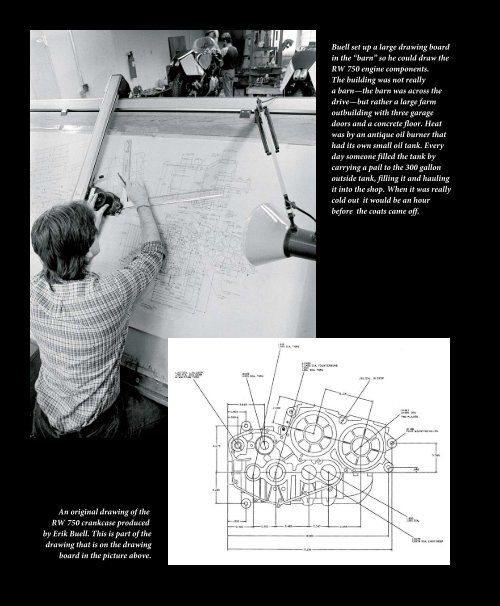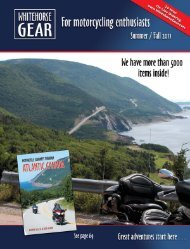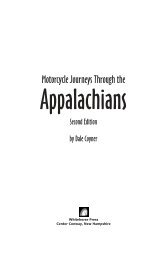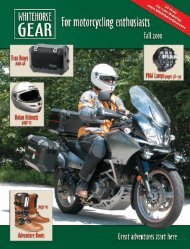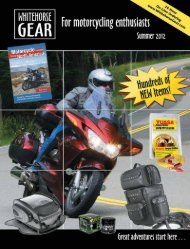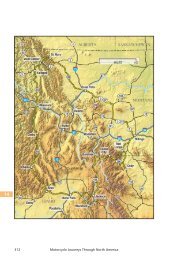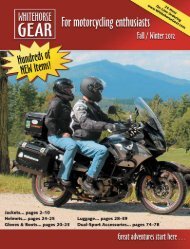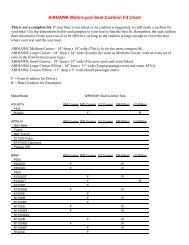Buell set up a large drawing board in the “barn ... - Whitehorse Gear
Buell set up a large drawing board in the “barn ... - Whitehorse Gear
Buell set up a large drawing board in the “barn ... - Whitehorse Gear
- No tags were found...
You also want an ePaper? Increase the reach of your titles
YUMPU automatically turns print PDFs into web optimized ePapers that Google loves.
<strong>Buell</strong> <strong>set</strong> <strong>up</strong> a <strong>large</strong> <strong>draw<strong>in</strong>g</strong> <strong>board</strong><strong>in</strong> <strong>the</strong> “barn” so he could draw <strong>the</strong>RW 750 eng<strong>in</strong>e components.The build<strong>in</strong>g was not reallya barn—<strong>the</strong> barn was across <strong>the</strong>drive—but ra<strong>the</strong>r a <strong>large</strong> farmoutbuild<strong>in</strong>g with three garagedoors and a concrete floor. Heatwas by an antique oil burner thathad its own small oil tank. Everyday someone filled <strong>the</strong> tank bycarry<strong>in</strong>g a pail to <strong>the</strong> 300 gallonoutside tank, fill<strong>in</strong>g it and haul<strong>in</strong>git <strong>in</strong>to <strong>the</strong> shop. When it was reallycold out it would be an hourbefore <strong>the</strong> coats came off.An orig<strong>in</strong>al <strong>draw<strong>in</strong>g</strong> of <strong>the</strong>RW 750 crankcase producedby Erik <strong>Buell</strong>. This is part of <strong>the</strong><strong>draw<strong>in</strong>g</strong> that is on <strong>the</strong> <strong>draw<strong>in</strong>g</strong><strong>board</strong> <strong>in</strong> <strong>the</strong> picture above.14
SILVER DREAM RACERErik <strong>Buell</strong> was born <strong>in</strong> 1950 <strong>in</strong> Gibsonia, Pennsylvania. His dad was atop notch patent attorney and his mom taught English. (Don’t turn <strong>in</strong>any document to Erik with grammatical errors; it will come back withall <strong>the</strong> errors marked <strong>up</strong>!) He was exposed to a lot of mechanical stuffon <strong>the</strong> farm; his dad collected <strong>in</strong>terest<strong>in</strong>g cars and by <strong>the</strong> 1960s hismotorcycle passion was <strong>in</strong> full bloom. His first motorcycle ride at age12 had ignited <strong>the</strong> flame that cont<strong>in</strong>ues to burn today. By <strong>the</strong> late ’60she’d begun work<strong>in</strong>g at bike shops and was rac<strong>in</strong>g motocross. Heworked for shops throughout <strong>the</strong> Pittsburgh area but perhaps <strong>the</strong> mostimportant was <strong>the</strong> one belong<strong>in</strong>g to Walter “Zero” F<strong>in</strong>negan. Zero wasa bit of a local legend, choos<strong>in</strong>g to run his own small shop ra<strong>the</strong>r thanuse his considerable mechanical skills to work for someone else. Hewas not a good fit for many of <strong>the</strong>se shops as he was a meticulouscraftsman and committed to giv<strong>in</strong>g customers <strong>the</strong> best service hecould. Erik took to heart Zero’s commitment to customer service and itrema<strong>in</strong>s a guid<strong>in</strong>g pr<strong>in</strong>ciple for Erik and <strong>Buell</strong> Motorcycles.Erik had tried his hand at be<strong>in</strong>g a rock star—didn’t we all at thatage—but it was tough to make any money. The baby boomer explosion<strong>in</strong> <strong>the</strong> motorcycle marketplace was well underway and competent mechanicswere <strong>in</strong> demand. Seriously good mechanics could make somereal money. Erik was one of <strong>the</strong> good ones. He essentially turned himself<strong>in</strong>to an <strong>in</strong>dependent contractor, work<strong>in</strong>g for whichever shopneeded a top-notch wrench. He could work on any brand and usuallycould beat <strong>the</strong> book rate while do<strong>in</strong>g first class work. If <strong>the</strong> shop askedhim to do someth<strong>in</strong>g he considered unethical, he would simply moveto ano<strong>the</strong>r shop. The fellow who wanted him to clean-<strong>up</strong> and quietdown <strong>the</strong> little Hodaka comes to m<strong>in</strong>d. This dealer planned to sell it tosome sucker as a 4-speed. It had come from <strong>the</strong> factory as a 5-speed but<strong>the</strong> tranny was fail<strong>in</strong>g. Erik refused to fake it and walked. Some shopswere a little rough. At one, a customer showed <strong>up</strong> with a shotgun and<strong>the</strong> owners faced him down with <strong>the</strong> pistols <strong>the</strong>y carried; Erik knew itwas time to move on.By <strong>the</strong> early ’70s <strong>the</strong> rac<strong>in</strong>g bug had bitten really hard and he wasrid<strong>in</strong>g on <strong>the</strong> fire roads <strong>in</strong> <strong>the</strong> area for hours each day to tra<strong>in</strong>. In 1972he was runn<strong>in</strong>g his F81M Kawasaki hard on a fire road when disasterstruck. He was flat out and sideways when com<strong>in</strong>g <strong>the</strong> o<strong>the</strong>r way was ayoung kid on a little dirt bike. The kid froze. Erik was runn<strong>in</strong>g so hard1979–1985 RW 75015
16he could not avoid a collision and took out <strong>the</strong> entire front end of <strong>the</strong>bike with his leg. The front wheel of Erik’s bike was destroyed and hisleg was crushed. The forks bent backwards so far that <strong>the</strong>y broke someof <strong>the</strong> f<strong>in</strong>s off <strong>the</strong> cyl<strong>in</strong>ders. With a shattered leg and bleed<strong>in</strong>g badlyErik was lucky that a Jeep came along and got him to <strong>the</strong> ER before hebled to death. It was a close th<strong>in</strong>g. When he was stabilized, one of <strong>the</strong>doctors wanted to amputate. Fortunately a different doc thought <strong>the</strong>leg could be saved. What pieces rema<strong>in</strong>ed were screwed <strong>in</strong>to a metalshaft and <strong>the</strong>y casted Erik from <strong>the</strong> hip to <strong>the</strong> toes. That was <strong>the</strong> end ofhis motocross/flat track career.Instead, when he could f<strong>in</strong>ally get <strong>up</strong> and move around, he took <strong>the</strong>motor from his crushed bike and comb<strong>in</strong>ed it with a 350cc cyl<strong>in</strong>derand a H1R Kawasaki frame to make a road-rac<strong>in</strong>g bike for a friend.They made it to Daytona <strong>in</strong> 1973 but shortly afterwards <strong>the</strong> fellow decidedhe wanted out. Erik bought <strong>the</strong> half his friend had provided andwent road rac<strong>in</strong>g. He had realized that even though he could not racemotocross with a cast he could get on a road racer.He turned out to be pretty good, runn<strong>in</strong>g at <strong>the</strong> front of a Noviceclass that <strong>in</strong>cluded <strong>the</strong> likes of Dave Roper, Richard Schlacter, and DaleS<strong>in</strong>gleton. He saw Gary Scott beat Kenny Roberts at Laconia on <strong>the</strong>Harley-Davidson RR250 GP bike and when <strong>the</strong>y became available forpurchase he just had to have one. He borrowed a lot of money to buyone and when it showed <strong>up</strong> for <strong>the</strong> 1974 season, it was horrible. Theproduction version was not even close to <strong>the</strong> bike Scott rode; <strong>the</strong>y wereunreliable and to top it off you couldn’t get spares. Erik watched <strong>in</strong>frustration as <strong>the</strong> fellows he had diced with as a Novice cont<strong>in</strong>ued tow<strong>in</strong> races and qualify for Expert while his bike would break and hewould slide fur<strong>the</strong>r down <strong>the</strong> list.Perhaps <strong>the</strong> low po<strong>in</strong>t of <strong>the</strong> season was <strong>the</strong> Talladega round. He hadcrashed <strong>the</strong> RR aga<strong>in</strong> by push<strong>in</strong>g too hard <strong>in</strong> a valiant but fruitless effortto make a slow bike go fast, and had a white gel-coated Yamaha fair<strong>in</strong>gmounted on <strong>the</strong> bike (you couldn’t buy a Harley-Davidson fair<strong>in</strong>g). Nopa<strong>in</strong>t, just a number. While driv<strong>in</strong>g all night to get to <strong>the</strong> race he stoppedat a truck stop and saw a very <strong>large</strong> decal of a leap<strong>in</strong>g bass. You know <strong>the</strong>ones; <strong>the</strong>y decorate <strong>the</strong> rear w<strong>in</strong>dows of campers all across America. Erikdecided it was just <strong>the</strong> th<strong>in</strong>g to brighten <strong>up</strong> <strong>the</strong> bor<strong>in</strong>g white gel coat.This decision may have had someth<strong>in</strong>g to do with lack of sleep, but forwhatever reason a pair of <strong>the</strong>se beauties ended <strong>up</strong> on <strong>the</strong> bike. When herolled <strong>the</strong> bike <strong>in</strong>to tech, <strong>the</strong> <strong>in</strong>spectors took one look and flunked him.They would not let him race until he took <strong>the</strong> decals off.
PittsburghPerformanceProductsErik <strong>Buell</strong> was your typical racer: alwaysstruggl<strong>in</strong>g to get enough money for rac<strong>in</strong>g.The really good parts were expensive, so<strong>Buell</strong>, not content with just be<strong>in</strong>g aconsumer, decided to become <strong>the</strong> U.S.distributor, under <strong>the</strong> name of PittsburghPerformance Products, for some of <strong>the</strong>products he wanted to use on his bike. Hegot on <strong>board</strong> with manufacturers of <strong>the</strong>best equipment out <strong>the</strong>re. He sold <strong>the</strong> verylightweight Dymag magnesium wheels, APRac<strong>in</strong>g brakes, and Interstate Lea<strong>the</strong>rs(despite <strong>the</strong> name <strong>the</strong>se were high qualityrace lea<strong>the</strong>rs made <strong>in</strong> England). Theexchange rate really favored <strong>the</strong> dollar sothis was a very nice little bus<strong>in</strong>ess.<strong>Buell</strong> also developed and patented a“sandwich” brake rotor. At <strong>the</strong> time brakerotors were ei<strong>the</strong>r cast iron, sta<strong>in</strong>less steel,or alum<strong>in</strong>um. Cast iron has excellent brakefeel, good heat transfer, and good life but isprone to rust and is very heavy. Alum<strong>in</strong>umis very light and has excellent heat transferproperties but wears out quickly.<strong>Buell</strong> addressed <strong>the</strong>se issues <strong>in</strong> hispatent application:“It has long been recognized that <strong>the</strong>removal of even a few ounces of unsprungweight was of tremendous advantage.”“I have discovered a brake disc whichsolves all <strong>the</strong>se problems. It is light <strong>in</strong>weight, has high <strong>the</strong>rmal transfercharacteristics, and is highly resistant to <strong>the</strong>wear and abrasion of <strong>the</strong> brake pucks.”<strong>Buell</strong>’s solution was to sandwich analum<strong>in</strong>um core between two sheets of sta<strong>in</strong>lesssteel. They had one-third less weight than a steelrotor plus much better heat transfer and a verylong life. The Wilke Bro<strong>the</strong>rs’ race team won twoUSAC National Midget Championships <strong>in</strong> <strong>the</strong>Sales literature was produced for <strong>the</strong>products <strong>Buell</strong> sold through hisPittsburgh Performance Productscompany to s<strong>up</strong>port his rac<strong>in</strong>g.1980s us<strong>in</strong>g just one <strong>set</strong> of brake rotors for anentire year.One of <strong>the</strong> po<strong>in</strong>ts that <strong>Buell</strong> stressed for <strong>the</strong>Dymag wheels and <strong>the</strong> <strong>Buell</strong> Brakes was <strong>the</strong>reduction <strong>in</strong> rotational mass and unsprungweight. You can see from <strong>the</strong> ads that <strong>Buell</strong>’scurrent ZTL brake system is not just “market<strong>in</strong>gspeak” but a fur<strong>the</strong>r development of a long-heldbelief.■17
Barton MotorsBarton was a t<strong>in</strong>y company founded <strong>in</strong> <strong>the</strong> mid-1970sto produce an English Formula One motorcycle. Mostof <strong>the</strong> Japanese Formula One bikes were run by teamslocated <strong>in</strong> England so <strong>the</strong>re was a lot of expertiseavailable to make parts. The eng<strong>in</strong>e was derived from aSuzuki. The first, and apparently only, complete bike<strong>the</strong>y built was for <strong>the</strong> movie “Silver Dream Racer”which starred David Essex. The chassis followedcommon wisdom at <strong>the</strong> time that too much stiffnesswas not good, and that <strong>the</strong> right amount of flex <strong>in</strong> <strong>the</strong>chassis would result <strong>in</strong> a nice-handl<strong>in</strong>g motorcycle.This sometimes actually worked for <strong>the</strong> underpowered,sk<strong>in</strong>ny-tired bikes of <strong>the</strong> early two-stroke era but with<strong>the</strong> power <strong>the</strong> 750 Barton was mak<strong>in</strong>g by 1981, aflexible frame was almost unridable.This brochure for <strong>the</strong> Barton company shows <strong>the</strong>Silver Dream Racer bike that was featured <strong>in</strong> <strong>the</strong> movieof <strong>the</strong> same name.■The primary function of rac<strong>in</strong>g tech <strong>in</strong>spection is to ensure <strong>the</strong>safety of <strong>the</strong> participants; secondary functions <strong>in</strong>volve meet<strong>in</strong>g <strong>the</strong> basicrules of <strong>the</strong> class you are runn<strong>in</strong>g. They are not try<strong>in</strong>g to catchcheat<strong>in</strong>g—if you have used <strong>the</strong> valve spr<strong>in</strong>gs from a 1936 S<strong>up</strong>er D<strong>up</strong>erwhile only 1935 valves are allowed, <strong>the</strong> post-race teardown is s<strong>up</strong>posedto catch that. They also enforce standards <strong>in</strong>volv<strong>in</strong>g appropriate decalsand <strong>the</strong> like but safety is <strong>the</strong> first and foremost task of <strong>the</strong> <strong>in</strong>spectors.Imag<strong>in</strong>e his surprise when Erik rolled his bike back to <strong>the</strong> pits to readyit for <strong>the</strong> first race only to f<strong>in</strong>d that <strong>the</strong> frame was cracked <strong>in</strong> threeplaces. Seems it was okay if his bike folded <strong>in</strong> half at 150 mph but it wasnot gonna have a big old bass on <strong>the</strong> side when it crashed!In <strong>the</strong> mid ’70s, to help raise money to s<strong>up</strong>port his rac<strong>in</strong>g and also tocut costs for parts, Erik <strong>set</strong> himself <strong>up</strong> under <strong>the</strong> name of PittsburghPerformance Products as a distributor for some of <strong>the</strong> parts he needed.This enterprise would prove to be a lifel<strong>in</strong>e at key po<strong>in</strong>ts <strong>in</strong> <strong>the</strong> future.While Erik was chas<strong>in</strong>g his road rac<strong>in</strong>g dreams and wrench<strong>in</strong>g atbike shops he was also pursu<strong>in</strong>g a mechanical eng<strong>in</strong>eer<strong>in</strong>g degree at <strong>the</strong>University of Pittsburgh. As he worked his way through school he alsoworked his way <strong>up</strong> <strong>the</strong> ranks of AMA road rac<strong>in</strong>g. He made LightweightExpert <strong>in</strong> 1977 and Formula One Expert <strong>in</strong> 1978. He graduatedfrom Pitt with a Mechanical Eng<strong>in</strong>eer<strong>in</strong>g degree <strong>in</strong> 1979.18
Harley-DavidsonErik had done well <strong>in</strong> school and his look of steely determ<strong>in</strong>ation surelydid noth<strong>in</strong>g to discourage potential employers, so he had his choice ofa few jobs <strong>in</strong>clud<strong>in</strong>g a very nice one <strong>in</strong> aerospace. Instead, he pursuedHarley-Davidson. They were <strong>the</strong> only American motorcycle companyand Erik had it very bad for motorcycles. Harley-Davidson would onlyrecruit locals and were not all that big on college grads. Erik had to gethimself to Milwaukee and talk his way <strong>in</strong>.That he did, and once <strong>the</strong>re his talent and drive quickly made an impact.He started out do<strong>in</strong>g test<strong>in</strong>g and analysis; his first job was track<strong>in</strong>g<strong>the</strong> oil usage on Shovelhead test bikes. This consumed a lot of timeas you might imag<strong>in</strong>e. Shovels were never known for be<strong>in</strong>g oil-tight.He quickly rose through <strong>the</strong> ranks to lead <strong>the</strong> chassis developmentteam for <strong>the</strong> FXR project.His personal rac<strong>in</strong>g was also <strong>in</strong> progress. He owned and raced aDucati and a TZ750 Yamaha, <strong>the</strong> latter runn<strong>in</strong>g <strong>in</strong> <strong>the</strong> old FormulaOne (F1) class. His rac<strong>in</strong>g program was mov<strong>in</strong>g along fairly well for aco<strong>up</strong>le of years but th<strong>in</strong>gs were about to change.The career at Harley-Davidson was go<strong>in</strong>g well. He was lead<strong>in</strong>g <strong>the</strong>chassis team on <strong>the</strong> FXRT project and as a result learn<strong>in</strong>g an enormousamount about real world motorcycle chassis dynamics. The teamhooked <strong>up</strong> test bikes with record<strong>in</strong>g gear and <strong>the</strong>n flogged <strong>the</strong>m around<strong>the</strong> Talladega test track, record<strong>in</strong>g what was happen<strong>in</strong>g. The result wasone of <strong>the</strong> sweetest handl<strong>in</strong>g Harleys of all time (<strong>the</strong>se bikes became oneof <strong>the</strong> favorite rides of <strong>the</strong> Hell’s Angels because of this), and a head fullof knowledge that Erik would f<strong>in</strong>d useful for years to come.Erik’s career was go<strong>in</strong>g well but his rac<strong>in</strong>g was not. He was fast but<strong>the</strong> Yamaha was old and wear<strong>in</strong>g out. He was also concerned aboutrac<strong>in</strong>g a Yamaha while Harley-Davidson was locked <strong>in</strong> a life-anddeathstruggle with Japanese manufacturers; it was becom<strong>in</strong>g <strong>in</strong>creas<strong>in</strong>glyobvious that rac<strong>in</strong>g a Yamaha while work<strong>in</strong>g for Harley was notappreciated by people <strong>in</strong> <strong>the</strong> corner offices.Erik considered two solutions to <strong>the</strong>se problems. The first <strong>in</strong>volvedan obscure British company called Barton Motors, which had built a750cc square four two-stroke race bike. The second <strong>in</strong>volved conv<strong>in</strong>c<strong>in</strong>gHarley-Davidson that <strong>the</strong>y should take <strong>the</strong> Sportster motor andbuild <strong>the</strong>mselves a real sportbike.19
20This dyno chart is from an RW 750 run that was made to tune <strong>the</strong> exhaustpipes. By this time <strong>the</strong>re was more <strong>Buell</strong> than Barton <strong>in</strong> <strong>the</strong> eng<strong>in</strong>e. It ga<strong>in</strong>sover 23 hp <strong>in</strong> less than 600 rpm when you hit 7500 rpm; ultimately ga<strong>in</strong><strong>in</strong>g 90hp <strong>in</strong> 3000 rpm to reach 163.5 hp at 10500 rpm. This is manageable <strong>in</strong> a racecar with nice fat slicks but try<strong>in</strong>g to feed <strong>in</strong> throttle while leaned over on a bikewas treacherous. Even with modern slicks this would be a handful; with 1980stires it was a recipe for high sides. <strong>Buell</strong> was able to smooth it out a bit bytun<strong>in</strong>g <strong>the</strong> pipes and carbs but it would never be an easy bike to ride. Before<strong>Buell</strong> designed a nice stiff chassis, it bordered on <strong>the</strong> suicidal.
Erik was watch<strong>in</strong>g <strong>the</strong> ambitious Barton motorcycle, which costarredwith David Essex <strong>in</strong> <strong>the</strong> B movie “Silver Dream Racer,” when<strong>the</strong> TZ’s chassis broke. The Barton looked to be <strong>the</strong> answer to his problems,so he bought <strong>the</strong> Barton bike <strong>in</strong> late 1980. Actually <strong>the</strong> bike wasjust <strong>the</strong> beg<strong>in</strong>n<strong>in</strong>g of his problems.The second solution got about as far as you might imag<strong>in</strong>e. It wouldreappear after <strong>the</strong> first solution collapsed but we will get to that later.The Barton bikes had shown potential with 500cc eng<strong>in</strong>es but <strong>the</strong><strong>large</strong>r 750cc displacement did noth<strong>in</strong>g to help <strong>the</strong>ir already questionablereliability. In addition, <strong>the</strong> chassis was decidedly marg<strong>in</strong>al. Not todisparage Barton—after all it was a co<strong>up</strong>le guys <strong>in</strong> an ancient abandonedchurch attempt<strong>in</strong>g <strong>the</strong> impossible—but <strong>the</strong>ir lack of resourcesresulted <strong>in</strong> a motorcycle that was not go<strong>in</strong>g to take Erik <strong>in</strong>to <strong>the</strong> <strong>up</strong>perreaches of <strong>the</strong> AMA pro ranks. However, it was fast. Erik felt he couldfix <strong>the</strong> problems. He was, after all, very knowledgeable about motorcyclechassis design.Did we say <strong>the</strong> Barton was fast? It was very fast. Erik would eventuallyget it to 178 mph with a peak horsepower of 163 at 10,500 rpm.This was more than enough to compete with <strong>the</strong> ubiquitous TZ750 <strong>in</strong>AMA F1 rac<strong>in</strong>g. There was of course one small issue. Its very flexibleframe would w<strong>in</strong>d and unw<strong>in</strong>d itself under hard corner<strong>in</strong>g. The resultwas unpredictable handl<strong>in</strong>g. If <strong>the</strong> motor had given you a nice broadpower curve, you could ride around <strong>the</strong> handl<strong>in</strong>g. Trouble was <strong>the</strong>power band was about as wide as a matchbook and when <strong>the</strong> power hit,all <strong>the</strong> matches lit at once. Plus, it liked to seize—often and withoutwarn<strong>in</strong>g. The th<strong>in</strong>g was a wicked, mean, and nasty SOB but when itwas right it had <strong>the</strong> power to kick <strong>the</strong> TZ750’s butt; a very seductivepackage for a determ<strong>in</strong>ed young eng<strong>in</strong>eer/racer.With Carm<strong>in</strong>e Vara, his friend and partner <strong>in</strong> <strong>the</strong> enterprise <strong>the</strong>ycalled Erm<strong>in</strong>e Rac<strong>in</strong>g, Erik struggled with <strong>the</strong> Barton through 1981 but<strong>the</strong> beast was constantly break<strong>in</strong>g. Erik was constantly call<strong>in</strong>g Englandfor parts. They persevered, <strong>in</strong>trigued by its potential.Then fate <strong>in</strong>tervened. In early 1982, Erik learned that Barry Hart(<strong>the</strong> mad Welshman beh<strong>in</strong>d Barton) had gotten a job offer from Britishbike maker Armstrong that he just could not refuse. The idea of an actualsteady <strong>in</strong>come was too much to pass <strong>up</strong> so he took it. Barton partswould become unavailable. Erik, as he likes to do, jumped <strong>in</strong> with bothfeet, buy<strong>in</strong>g <strong>the</strong> whole Barton deal, lock, stock, and porous crankcasecast<strong>in</strong>gs. He really had little choice. If parts became unavailable, Erikwould not have a bike to race <strong>in</strong> F1. Go<strong>in</strong>g back to race a productionCarm<strong>in</strong>e Vara and Erik produced<strong>the</strong>se packets <strong>in</strong> an effort to attractsponsorship for what wouldeventually become <strong>the</strong> RW 750.They got no takers.21
Bill Meyer <strong>in</strong> his <strong>Buell</strong> powered Ocelot at Road Atlanta for <strong>the</strong> 1985SCCA National Championship races. Meyer was <strong>the</strong> last of <strong>the</strong> sports carguys to give <strong>the</strong> eng<strong>in</strong>e a try. Meyer found <strong>the</strong> motor “reliable and fast.”He won <strong>the</strong> SCCA round at Summit Po<strong>in</strong>t <strong>in</strong> August, but at <strong>the</strong> NationalChampionship races <strong>the</strong> ignition system failed. That was <strong>the</strong> last gasp for<strong>the</strong> <strong>Buell</strong>-Barton eng<strong>in</strong>e.Not on Two WheelsThis advertisement for <strong>the</strong> sportscar motor ran <strong>in</strong> Sports Carmagaz<strong>in</strong>e.Dave Ammen and Greg Ru<strong>the</strong>rford purchased Barton eng<strong>in</strong>es touse <strong>in</strong> a SCCA D-sports racer. This class allowed 850cc eng<strong>in</strong>es ofany configuration. The Barton had a real power advantage overo<strong>the</strong>r available eng<strong>in</strong>es but proved to be very fragile. “We wereconsistently faster than everyone else, but we could not get <strong>the</strong>eng<strong>in</strong>e to last,” Ammen said. “It needed more work and f<strong>in</strong>ancialback<strong>in</strong>g than we were able to give it.” Ammen had to make hisown <strong>set</strong> of gears. “The gears were just not able to handle <strong>the</strong>weight of <strong>the</strong> car,” said Ammen. Fortunately he was <strong>in</strong> <strong>the</strong>bus<strong>in</strong>ess of mak<strong>in</strong>g gears. He managed a co<strong>up</strong>le of w<strong>in</strong>s andqualified for <strong>the</strong> National Championships a few times but gave<strong>up</strong> after not be<strong>in</strong>g able to overcome <strong>the</strong> reliability issues.The 750cc eng<strong>in</strong>e also saw use <strong>in</strong> Nigel Rollason’s sidecar rigat <strong>the</strong> Isle of Man TT and it is <strong>the</strong>re that Barton had its bestresults. Rollason managed a second <strong>in</strong> 1979 and a first and third<strong>in</strong> 1986. He was consistently fast from 1979 until 1987. By <strong>the</strong>time of his victory <strong>Buell</strong> owned Barton and some of <strong>the</strong> pieces <strong>in</strong><strong>the</strong> w<strong>in</strong>n<strong>in</strong>g chair were more <strong>Buell</strong> than Barton.■22
ike after runn<strong>in</strong>g <strong>in</strong> <strong>the</strong> premier class was not an acceptable option soErik really had to buy Barton. He was conv<strong>in</strong>ced he could make <strong>the</strong>bus<strong>in</strong>ess work and sell some motorcycles. There was a market for a decently-pricedreplacement for <strong>the</strong> TZ750 <strong>in</strong> AMA rac<strong>in</strong>g. It took untilvery late <strong>in</strong> 1982 to arrange all <strong>the</strong> details and <strong>the</strong>n <strong>in</strong> early 1983 Erikwrote <strong>the</strong> check. He was <strong>in</strong> <strong>the</strong> motorcycle bus<strong>in</strong>ess. Unfortunately, by<strong>the</strong> time <strong>the</strong> pieces all arrived, <strong>the</strong> 1983 race season was half over andvaluable development time was lost.Development of <strong>the</strong> RW 750Erik labored on cont<strong>in</strong>u<strong>in</strong>g to develop what was now be<strong>in</strong>g called <strong>the</strong>RW 750 motorcycle. Then <strong>in</strong> <strong>the</strong> spr<strong>in</strong>g of ’84 he conv<strong>in</strong>ced Harley-Davidson to witness a test at Talladega (a track where Harley-Davidson rents countless hours of test<strong>in</strong>g time) hop<strong>in</strong>g to get <strong>the</strong>m totake <strong>the</strong> project under <strong>the</strong>ir w<strong>in</strong>g and get him <strong>the</strong> resources to competeIt usually looked like this <strong>in</strong> <strong>the</strong> shopat <strong>the</strong> farm, where you can see onepartially assembled RW 750 andone bare frame.23
24When <strong>the</strong> first “production” RW 750was f<strong>in</strong>ished, Erik <strong>Buell</strong> and DaveGess <strong>set</strong> <strong>up</strong> a photo shoot. Dave hadaccess to a portrait studio at thattime; it was decidedly marg<strong>in</strong>al forwhat he had <strong>in</strong> m<strong>in</strong>d but when youhave no money, you have to make itwork. (Mak<strong>in</strong>g it work was arecurr<strong>in</strong>g <strong>Buell</strong> <strong>the</strong>me!) Daveborrowed yards of black velvetmaterial from a photographer friendand draped <strong>the</strong> studio <strong>in</strong> it. Twoexposures were taken, one with <strong>the</strong>bodywork off and one with it on.The result is this ghost image. Erikwould later credit this picture as <strong>the</strong><strong>in</strong>spiration for <strong>the</strong> translucentbodywork on <strong>the</strong> City-Crossmodel of 2005.
<strong>in</strong> <strong>the</strong> Daytona 200. Doug Brauneck would ride <strong>the</strong> bike, Erik wouldwrench, and Harley-Davidson would watch. They offered no money tohelp <strong>the</strong> test along so Erik arrived on his usual shoestr<strong>in</strong>g.Brauneck ran a dozen laps and was very fast <strong>in</strong>deed. A speed of 178mph was recorded on <strong>the</strong> radar gun and <strong>the</strong> handl<strong>in</strong>g was great. Hisspeed was such that Harley-Davidson began to believe that runn<strong>in</strong>gcompetitively at Daytona was not a fantasy. They wanted to see justhow <strong>the</strong> bike would do over 200 miles.This seem<strong>in</strong>gly delightful result of <strong>the</strong> test was <strong>the</strong> RW’s downfall.Because of <strong>the</strong> time constra<strong>in</strong>ts Harley needed to run <strong>the</strong> test thatweekend. The only tires available that would survive <strong>the</strong> bank<strong>in</strong>g forany length of time lowered <strong>the</strong> bikes gear<strong>in</strong>g. Erik, be<strong>in</strong>g broke, did nothave any gears that would allow <strong>the</strong> bike to run fast and stay below redl<strong>in</strong>eon <strong>the</strong> Talladega bank<strong>in</strong>g. Brauneck ran some very, very fast laps.The eng<strong>in</strong>e seized. Erik fixed it. It seized aga<strong>in</strong>. Turned out one of <strong>the</strong>rotary valves was <strong>in</strong>correctly mach<strong>in</strong>ed and that cyl<strong>in</strong>der was lean<strong>in</strong>gout at maximum rpm. Harley was not happy; Erik was still on his own.Now a regular guy like you or I might say at this po<strong>in</strong>t “Damn, thatdidn’t work. Glad I have a day job to pay <strong>the</strong> bills.” Erik is not a regularguy. He decided that if he had more time he could get this th<strong>in</strong>g work<strong>in</strong>gright and have bikes to sell by <strong>the</strong> fall. To get <strong>the</strong> extra time he quit avery nice job at Harley-Davidson. (Actually, he tried to quit, but JeffBleuste<strong>in</strong> made him take an extended leave of absence so he wouldThe RW 750 eng<strong>in</strong>e was a 66.4 x54.0 mm bore and stroke, rotaryvalve square four. It featured twotw<strong>in</strong>-cyl<strong>in</strong>der crankshafts gearedtoge<strong>the</strong>r. There are four separatecyl<strong>in</strong>ders. Many of <strong>the</strong> partswere designed or redesignedby <strong>Buell</strong>, <strong>in</strong>clud<strong>in</strong>g <strong>the</strong> pistonsand <strong>the</strong> flywheel. The eng<strong>in</strong>estarted life as a 500; <strong>the</strong>re wasalso an 850 version <strong>in</strong> additionto <strong>the</strong> 750 that <strong>Buell</strong> raced.25
Doug Brauneck on <strong>the</strong> RW 750 prototype dur<strong>in</strong>g practice at Road America <strong>in</strong> 1984.Road AmericaBy <strong>the</strong> summer of 1984, <strong>Buell</strong> had fixed mostof <strong>the</strong> RW’s problems and was runn<strong>in</strong>g <strong>the</strong>bike <strong>in</strong> as many AMA Nationals as he couldafford. The goal was to sell bikes. At RoadAmerica that year Doug Brauneck, one of <strong>the</strong>top privateers, was entered to ride <strong>the</strong> bike. Hedid a lot of practice laps and was impressed,but he was concerned about reliability and, at<strong>the</strong> very last m<strong>in</strong>ute, decided to stick with <strong>the</strong>slower but reliable Yamaha TZ750. Erikliterally jumped <strong>in</strong>to his lea<strong>the</strong>rs and ran to<strong>the</strong> start l<strong>in</strong>e. He only completed one lap before<strong>the</strong> water pump drive sheared. Dave Gessmanaged to get one shot of him a<strong>board</strong> <strong>the</strong>bike. (See page 6)The next race was at Pocono. On <strong>the</strong>Monday before <strong>the</strong> race, <strong>Buell</strong> jo<strong>in</strong>ed a fewfriends who had rented Blackhawk Farms racetrack outside of Beloit, Wiscons<strong>in</strong>, and ran afew laps to make sure he had fixed <strong>the</strong> waterpump problem. The bike ran great until itseized <strong>in</strong> turn one and highsided <strong>Buell</strong> to <strong>the</strong>ground. He broke three ribs. The bike did notrun at Pocono.■Erik <strong>Buell</strong> and John Hasty discuss <strong>the</strong> RW.26
have <strong>the</strong> option of com<strong>in</strong>g back after six months. He was not com<strong>in</strong>gback.) His part<strong>in</strong>g was on exceptionally good terms—someth<strong>in</strong>g thatwould prove important <strong>in</strong> <strong>the</strong> future.To develop a race bike Erik needed cash, so he sold his d<strong>up</strong>lex andfound a run-down farm to rent <strong>in</strong> Mukwonago, Wiscons<strong>in</strong>. The farmwas a long way from any neighbors and had a nice garage build<strong>in</strong>g aswell as a barn. It was an ideal place to build and test a race bike. Hewould generate some <strong>in</strong>come by stepp<strong>in</strong>g <strong>up</strong> his Pittsburgh PerformanceProducts bus<strong>in</strong>ess.The RW 750 really was, as <strong>the</strong> hot rodders say, “sanitary.” Lots of attentionto detail is evident <strong>in</strong> <strong>the</strong> construction of <strong>the</strong> chassis. It hadmostly straight tubes for maximum stiffness. The eng<strong>in</strong>e was mountedwell forward to keep weight on <strong>the</strong> front end. The front suspension wasMarzocchi with <strong>the</strong> patented Harley-Davidson electro-pneumaticanti-dive system (which Erik <strong>in</strong>vented). The rear suspension was a s<strong>in</strong>gleWorks Performance unit. The axles were thicker than usual 1980spractice; <strong>the</strong> front was 20 mm versus <strong>the</strong> usual 17 and <strong>the</strong> rear was 25mm versus 20. The bear<strong>in</strong>gs were out aga<strong>in</strong>st <strong>the</strong> fork tubes. None ofthis was common 1980s practice but resulted <strong>in</strong> a much stiffer axle. Increas<strong>in</strong>gstiffness is a <strong>the</strong>me cont<strong>in</strong>ued across <strong>the</strong> entire history of <strong>Buell</strong>motorcycles.The bodywork not only looked good but shows <strong>the</strong> beg<strong>in</strong>n<strong>in</strong>gs of<strong>Buell</strong>’s <strong>in</strong>terest <strong>in</strong> aerodynamics. It started with <strong>the</strong> basic shape of <strong>the</strong>1969 Harley-Davidson Cal Rayburn streaml<strong>in</strong>er developed <strong>in</strong> CalThe one-car garage <strong>in</strong> Milwaukee,where Erik started to develop <strong>the</strong>RW 750, became <strong>in</strong>creas<strong>in</strong>glydifficult to work <strong>in</strong> as <strong>the</strong> RW 750project grew. This farm nearMukwonago, Wiscons<strong>in</strong>, was aperfect location for <strong>the</strong> project. Thebarn itself, on <strong>the</strong> left, was used forstorage of lea<strong>the</strong>rs, wheels, andgeneral parts. The small build<strong>in</strong>g <strong>in</strong>front of <strong>the</strong> barn was <strong>the</strong> office. Itmay have started life as a milk<strong>in</strong>gshed and is attached to <strong>the</strong> barn.The out-build<strong>in</strong>g on <strong>the</strong> right was<strong>the</strong> actual “factory” where <strong>the</strong>RW 750 was made and earlyRR 1000s were built.27
In <strong>the</strong> w<strong>in</strong>ter of 1984-85 Kev<strong>in</strong>Cameron authored a feature story forCycle magaz<strong>in</strong>e. This portrait wastaken for that story. You can reallysee <strong>the</strong> pride radiat<strong>in</strong>g from Erik<strong>Buell</strong> as he poses with <strong>the</strong> RW 750.Tech’s w<strong>in</strong>d tunnel. Careful attention given not only to airflow over <strong>the</strong>bodywork but also through <strong>the</strong> radiators resulted <strong>in</strong> a very efficient,aerodynamic package. At <strong>the</strong> time, most fair<strong>in</strong>gs were simply covers,with little attention paid to how <strong>the</strong>y actually worked mov<strong>in</strong>g through<strong>the</strong> air. Some period race bikes were faster without <strong>the</strong> fair<strong>in</strong>gs.By 1984, <strong>the</strong> new bike was ready and media kits went out. Cyclemagaz<strong>in</strong>e sent Kev<strong>in</strong> Cameron out to write a major feature article thatappeared <strong>in</strong> <strong>the</strong> July 1985 issue. One bike was sold and a second salewas pend<strong>in</strong>g. It looked like <strong>the</strong> gamble was go<strong>in</strong>g to work. America hada new motorbike company. Then, <strong>in</strong> spr<strong>in</strong>g of 1985, <strong>the</strong> AMA pulled<strong>the</strong> plug on <strong>the</strong> class. Formula One would go away and <strong>the</strong> grow<strong>in</strong>gS<strong>up</strong>erbikes would become <strong>the</strong> premier class. Overnight Erik’s marketwas gone and along with it his bus<strong>in</strong>ess.28
Alan Ladd a<strong>board</strong> <strong>the</strong> Mach<strong>in</strong>ist Union RW 750 prepares to go outfor practice at Daytona. Ken W<strong>in</strong>pis<strong>in</strong>ger is stand<strong>in</strong>g at <strong>the</strong> left.Mach<strong>in</strong>ist Union BikeOne RW 750 was sold. On January 14, 1985,this was delivered to Kenneth W<strong>in</strong>pis<strong>in</strong>ger of <strong>the</strong>Mach<strong>in</strong>ist’s Union. “Alan Ladd and I had beenrac<strong>in</strong>g locally and w<strong>in</strong>n<strong>in</strong>g a lot,” saidW<strong>in</strong>pis<strong>in</strong>ger. “My dad was president of <strong>the</strong>Union and <strong>the</strong>y sponsored an Indy Car team.I’m th<strong>in</strong>k<strong>in</strong>g to myself ‘<strong>the</strong>y should sponsor us’and <strong>the</strong>n I saw a magaz<strong>in</strong>e story on <strong>the</strong> <strong>Buell</strong>and showed it to my dad over d<strong>in</strong>ner. The Unionwas always look<strong>in</strong>g to promote American-madeproducts. I jok<strong>in</strong>gly told Dad, ‘I should get oneof <strong>the</strong>se and you guys sponsor us.’ He said ‘Goget it.’ I just about fell over. I called Erik andbought one.”The plan was to run <strong>the</strong> 1985 AMA seasonwhich kicks off at Daytona. “It would be better tostart a new race program somewhere o<strong>the</strong>r thanDaytona,” said W<strong>in</strong>pis<strong>in</strong>ger, “if you are not 100percent ready to go, that place will hurt you.”It certa<strong>in</strong>ly did hurt <strong>the</strong>m. The bike seized <strong>in</strong>practice out on <strong>the</strong> bank<strong>in</strong>g between NASCARturn three and four. Top gear was about 160-170 mph. Ladd managed not to crash and <strong>the</strong>ygot <strong>the</strong> motor back <strong>up</strong> and runn<strong>in</strong>g by race day.“What I didn’t realize at <strong>the</strong> time was <strong>the</strong>amount of damage done to <strong>the</strong> rest of <strong>the</strong> eng<strong>in</strong>ewhen it seized. We kept hav<strong>in</strong>g issues at <strong>the</strong>next several races and it f<strong>in</strong>ally dawned on methat <strong>the</strong>y all could be traced back to thatseizure. There was a lotta stuff we should havedone right away that we didn’t th<strong>in</strong>k about. Itwas a learn<strong>in</strong>g curve for all of us, that’s forsure,” W<strong>in</strong>pis<strong>in</strong>ger said.The bike did not qualify at Daytona but <strong>the</strong>ywere told to be on <strong>the</strong> grid to replace any nonstarters.A few guys didn’t make <strong>the</strong> race but <strong>the</strong>AMA official at <strong>the</strong> l<strong>in</strong>e straddled <strong>the</strong> front tireand grabbed <strong>the</strong> far<strong>in</strong>g not lett<strong>in</strong>g <strong>the</strong>m go out.He actually wrenched <strong>the</strong> fair<strong>in</strong>g so hard hecracked it. They never ran a lap. To add <strong>in</strong>sult to<strong>in</strong>jury <strong>the</strong>y were listed as 80th, last place <strong>in</strong> <strong>the</strong>official results posted <strong>the</strong> next day. “I wasfurious, <strong>the</strong>y wouldn’t let us start and <strong>the</strong>n <strong>the</strong>ysaid we f<strong>in</strong>ished last,” said W<strong>in</strong>pis<strong>in</strong>ger.The best f<strong>in</strong>ish all year was second <strong>in</strong> a clubrace at Summit Po<strong>in</strong>t at <strong>the</strong> end of year. “I feltwe had a pretty good package by <strong>the</strong> end of <strong>the</strong>season and was confident that we would havedone well if <strong>the</strong> class had survived,” W<strong>in</strong>pis<strong>in</strong>gersaid. “It was very frustrat<strong>in</strong>g.”■29


